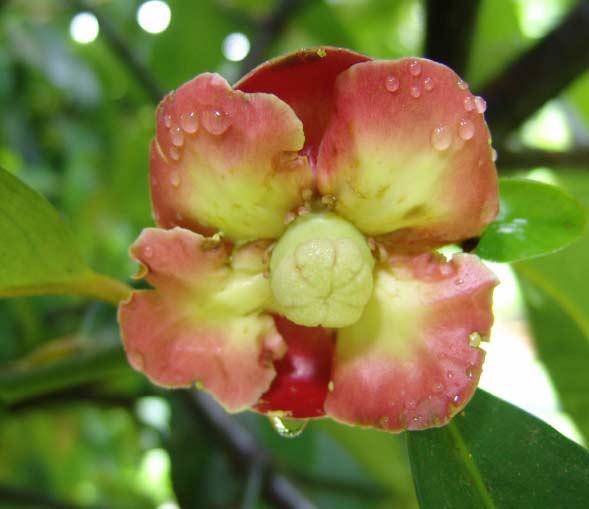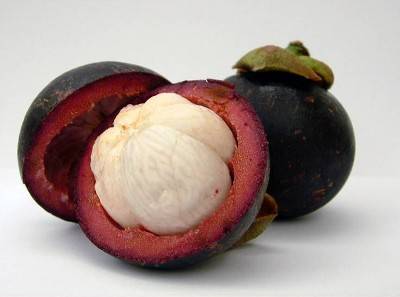The delicate and delicious flavor of the fruit of the mangosteen tree has encouraged some local gardeners to grow this plant. Since it can take up to 15 years for a mangosteen tree to fruit, growing it may only appeal to those who plan to be gardening for the next 20 years or so. With a little care and lots of patience, the tree will grow well in West Hawaii, however, and reward your efforts with a bounty of luscious fruit.
The delicate and delicious flavor of the fruit of the mangosteen tree has encouraged some local gardeners to grow this plant. Since it can take up to 15 years for a mangosteen tree to fruit, growing it may only appeal to those who plan to be gardening for the next 20 years or so. With a little care and lots of patience, the tree will grow well in West Hawaii, however, and reward your efforts with a bounty of luscious fruit.
Mangosteen trees likely originated in the Indonesian archipelago in the Moluiccas and Sunda Islands. Known botanically as Garcinia mangostana, they are in the relatively small Clusiaceae family, with only a few local relatives including the autograph tree (Clusia rosea). Mangosteens can only grow in specific tropical locales that are able to provide the narrow temperature range and climatic conditions they need to survive. Known as an ultra-tropical tree, they cannot survive temperatures below 45 degrees or above 100 degrees. They also require high humidity and lots of water to thrive. Some commercial cultivation of mangosteens is currently in progress at lower elevations on the Hilo side. With careful attention to their needs they can be grown successfully in West Hawaii, as well.
Beloved by Queen Victoria of England, the “Queen of Fruits” grows on a tree that has several appealing physical characteristics as a landscape plant. A tropical evergreen, the mangosteen has attractive thick, leathery dark green leaves that are glossy on the surface. When they first appear, however, they are rose colored; changing to dark green as they mature. The leaves are supported on a trunk and branches with dark brown, nearly black, flaking bark with an inner bark that contains latex. After many years, the tree will support a dense pyramidal crown. Flowers, which may appear after about five years, are nearly 3 inches across and a lovely pink color with cream centers.
Though the tree grows very slowly, it can get quite tall in ideal conditions. Here in Hawaii, it usually reaches about 30 feet, but that may take as many years. Growing at about a foot a year, a two-year-old seedling may only be a little more than 12 inches tall. The trees are sensitive to salt spray and strong winds. They will grow best planted near streams or ponds or bodies of fresh water that keep at least portions of their roots moist year round. Though they prefer locations that get more than 50 inches of rain annually, they can be maintained in west Hawaii between 500 and 1,000 feet elevation in a partial shade location with frequent irrigation and a good mulch layer to retain moisture in the roots.
At maturity (usually well beyond 10 years) fruit may develop that forms from the center of the flower and is light green as it ripens. When ripe it becomes deep reddish purple and measures about 3 inches around. The calyx of the flower remains attached to the fruit when it is picked. In ideal conditions, a mangosteen tree can produce more than 500 fruits a year. The trees are long-lived and may continue to produce for 100 years.
The thick purple rind of the fruit is sometimes used for dyes and can stain your hands or clothes if not handled carefully. The soft white flesh of the fruit is revealed upon opening. The segmented fruit is actually the flower arils and usually includes six or more segments each containing a seed. The fruit is best eaten out of hand, delighting the taster with its juicy lusciousness. Most report the tangy sweet flavor is well worth the long wait.
In 1930, the great plant explorer David Fairchild wrote a vivid description of eating a mangosteen from his garden in southern Florida.
“It is so delicate that it melts in the mouth like ice cream. The flavor is quite indescribably delicious. There is nothing to mar the perfection of this fruit, unless it be that the juice from the rind forms an indelible stain on a white napkin.”
Hard black seeds are found in each mangosteen segment. They remain viable for only about five days so they must be planted soon after removing them from the fruit. They will not survive drying or storing for very long. If you decide to try growing trees from seed, it is best to direct seed in place as their long tap root and supporting surface roots are extremely sensitive and the trees do not transplant well. Soaking the seeds in water for 24 hours will speed germination. Plant the fresh seeds about 8 inches deep in rich soil amended with organic compost. The tap root will need about 4 feet of soil to grow to its full extent. Seedlings should appear in less than one month and they will soon develop their tap root.
In addition to needing moist soil year-round, mangosteen trees need to be fed a balanced fertilizer on a regular basis. After about five years, the tree may need occasional pruning to maintain a desirable shape. Keeping its naturally thick crown will increase the chances for fruiting, however.
Mangosteens seldom are attacked by insects because of the bitter latex exuded from their inner bark. Diseases are infrequent, as well. Root rot can kill them if the soil is too wet or doesn’t drain well. It is very important to keep the soil moist but not wet.
Though mangosteens have been reported to contain medicinal properties, production for medicine has not been developed here. Their very specific growing conditions are usually attempted only by those who have tasted the fruit and are excited to have a constant supply available.
Call around to find mangosteen trees in stock. Tropical Fruit and Edibles Nursery in Captain Cook, Sunrise Nursery in Kailua-Kona or any nursery that buys from Plant-it Hawaii should be able to order them for you if they don’t have them available.
If you can maintain the climatic requirements of a mangosteen, you will be rewarded with a lovely tree and fruit.
Diana Duff is a plant adviser, educator and consultant living on an organic farm in Captain Cook.




